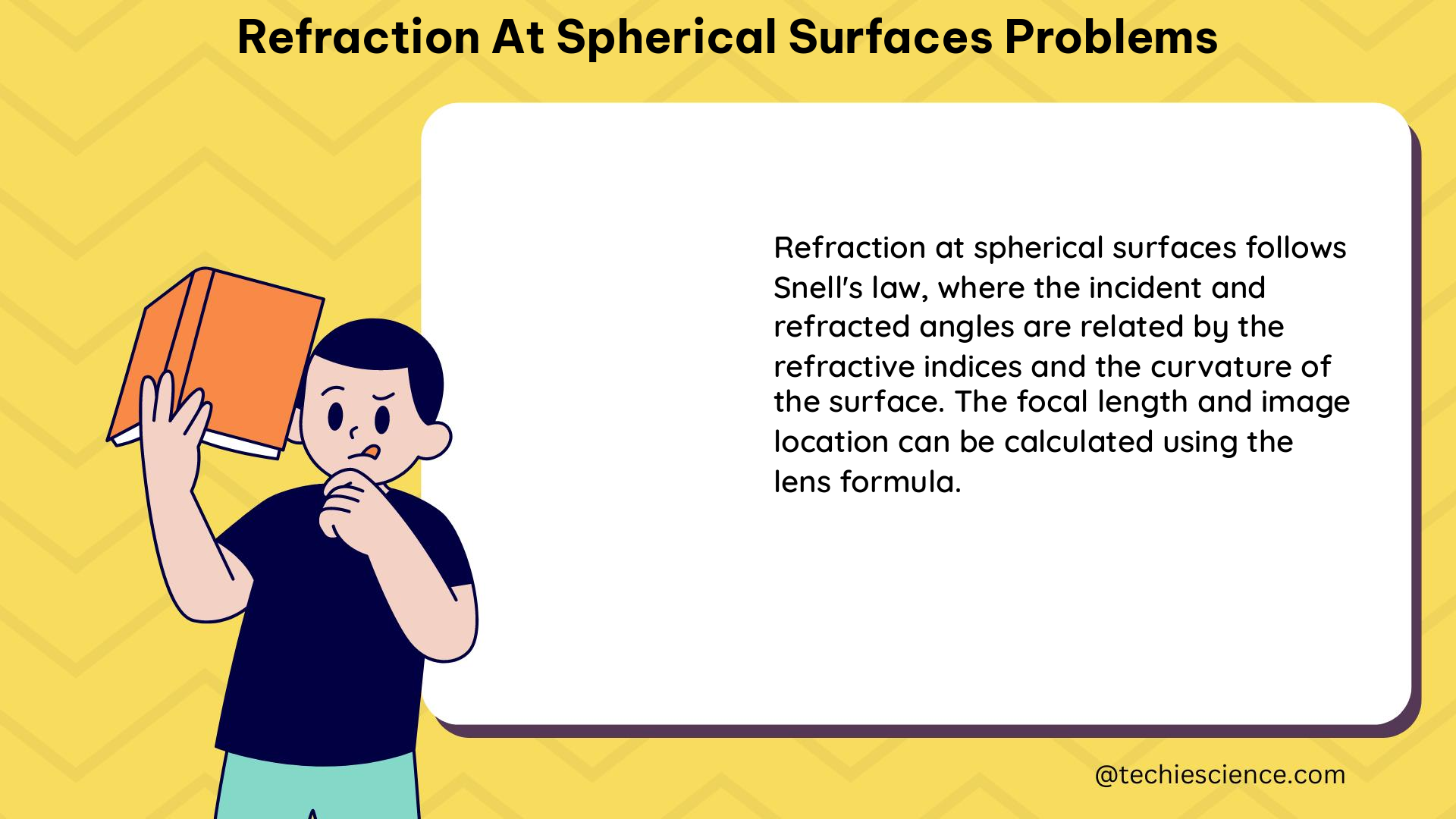Refraction at spherical surfaces is a fundamental concept in geometric optics, which describes the behavior of light as it passes from one medium to another with a different refractive index. This phenomenon has numerous applications in various fields, including optical engineering, photography, and even in the study of the human eye. In this comprehensive guide, we will delve into the intricacies of refraction at spherical surfaces, covering both theoretical explanations and practical problem-solving techniques.
Practice Problems
Let’s explore some real-world problems involving refraction at spherical surfaces:
1. Turtle and Dog Problem
- Radius of the glass tank: 25 cm
- Distance of the dog’s nose from the tank’s outside edge: 10 cm
- Refractive index of water: 1.33 (assuming the glass tank’s thickness can be ignored)
- Calculate the distance of the dog’s nose from the outside edge of the tank from the turtle’s perspective using Snell’s Law.
2. Laser Beam and Spherical Crystal
- Refractive index of the crystal: To be determined
- Convergence point: On the crystal’s rear surface
- Calculate the angle of incidence and refraction using Snell’s Law.
3. Glass Sphere and Diamond
- Radius of the glass sphere: 9.0 cm
- Distance of the diamond from the sphere’s surface: 8.0 cm
- Refractive index of glass: Typically around 1.5
- Calculate the distance of the diamond image from the sphere’s center using Snell’s Law.
4. Rubber Duck in a Flask
- Diameter of the flask: 44 cm
- Distance of the duck from the flask’s wall: 15 cm
- Refractive index of water: 1.33
- Calculate the apparent distance and magnification of the duck using Snell’s Law.
5. Cylinder-Shaped Diamond and Rubik’s Cube
- Radius of the spherical surface: 6 cm
- Distance of the Rubik’s cube from the vertex: 30 cm
- Refractive index of diamond: 2.41
- Calculate the distance and height of the image using Snell’s Law.
Theoretical Explanation

1. Snell’s Law
- Refractive indices of the two media: $n_1$ and $n_2$
- Angles of incidence and refraction: $x$ and $y$
- Snell’s Law equation: $n_1 x = n_2 y$
2. Small Angle Approximation
- Approximation for small angles: $\sin(w) \approx w$
- Used to simplify Snell’s Law for small angles
3. Ray Tracing Techniques
- Ray tracing for convex and concave boundaries
- Image formation and characteristics (inverted, shrunken, upright, etc.)
Figures and Data Points
1. Convex Boundary Diagram
- Ray tracing diagram for a convex boundary
- Image formation and characteristics
2. Concave Boundary Diagram
- Ray tracing diagram for a concave boundary
- Image formation and characteristics
Measurements and Values
1. Refractive Indices
- Water: 1.33
- Glass: Typically around 1.5
- Diamond: 2.41
2. Radii and Distances
- Radius of the glass tank: 25 cm
- Radius of the glass sphere: 9.0 cm
- Radius of the spherical surface of the diamond: 6 cm
- Diameter of the flask: 44 cm
- Distance of the dog’s nose from the tank’s outside edge: 10 cm
- Distance of the diamond from the sphere’s surface: 8.0 cm
- Distance of the duck from the flask’s wall: 15 cm
- Distance of the Rubik’s cube from the vertex: 30 cm
Theorems and Formulas
1. Snell’s Law
- $n_1 x = n_2 y$
2. Small Angle Approximation
- $\sin(w) \approx w$
3. Ray Tracing Equations
- $AB = Rx$
- $AB = fz = f(x – y)$
- $z = x – y$
Numerical Problems
1. Turtle and Dog Problem
- Calculate the distance of the dog’s nose from the outside edge of the tank from the turtle’s perspective.
2. Laser Beam and Spherical Crystal
- Determine the refractive index of the crystal.
3. Glass Sphere and Diamond
- Calculate the distance of the diamond image from the sphere’s center.
4. Rubber Duck in a Flask
- Calculate the apparent distance and magnification of the duck.
5. Cylinder-Shaped Diamond and Rubik’s Cube
- Calculate the distance and height of the image.
Reference Links
- Refraction at Spherical Surfaces
- Geometric Optics: Refraction at Spherical Surfaces
- Refraction at Curved Surfaces
This comprehensive guide covers the essential aspects of refraction at spherical surfaces, including practice problems, theoretical explanations, figures, data points, measurements, and numerical problem-solving techniques. By understanding these concepts, physics students can develop a strong foundation in geometric optics and apply these principles to real-world scenarios.

The lambdageeks.com Core SME Team is a group of experienced subject matter experts from diverse scientific and technical fields including Physics, Chemistry, Technology,Electronics & Electrical Engineering, Automotive, Mechanical Engineering. Our team collaborates to create high-quality, well-researched articles on a wide range of science and technology topics for the lambdageeks.com website.
All Our Senior SME are having more than 7 Years of experience in the respective fields . They are either Working Industry Professionals or assocaited With different Universities. Refer Our Authors Page to get to know About our Core SMEs.